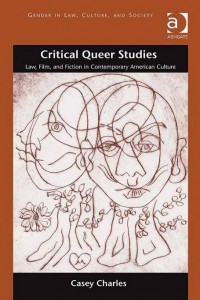Critical Queer Studies: Law, Film and Fiction in Contemporary American Culture by Casey Charles (Ashgate Publishing, 2012). 191 pages. ISBN: 978-1-4094-4406-0 (hardback), £60.00
 About the reviewer: Sharif Mowlabocus' primary research interests are located at the intersection of sexuality/queer studies and digital media studies. Since 1999 his research and study has focused on LGBTQ identities and practices, with a particular emphasis on their representation within mainstream and queer online media. Based within the School of Media, Film and Music at the University of Sussex, his work draws upon cultural theory, anthropology, cultural geography and social history as well as media and communication theory.
Email: S.J.Mowlabocus@sussex.ac.uk
About the reviewer: Sharif Mowlabocus' primary research interests are located at the intersection of sexuality/queer studies and digital media studies. Since 1999 his research and study has focused on LGBTQ identities and practices, with a particular emphasis on their representation within mainstream and queer online media. Based within the School of Media, Film and Music at the University of Sussex, his work draws upon cultural theory, anthropology, cultural geography and social history as well as media and communication theory.
Email: S.J.Mowlabocus@sussex.ac.uk
In Critical Queer Studies, Lawyer turned English Professor, Casey Charles, explores the relationship between screen representations of queer lives and the legal contexts that continue to define – and oppress – queer subjects in the USA today. Taking a case study approach, Charles is able to investigate different aspects of this relationship, tackling issues as diverse as Tort Law, gay marriage legislation, the homosexual panic defence and jury appointment. These legal concerns are married to, and inform, close textual readings of popular films that document the lives of LGBTQ people.
With one exception, the representations chosen focus on the biographies of real queer folk – Harvey Milk, Matthew Sheppard, Brandon Teena. Such choices allow the author to critique not only the media representation of these real life folk, but also provides a means of connecting such representations to the legal frameworks that have been applied to the lives – and particularly the deaths – of those represented. This is an innovative approach that serves the book’s argument well. It also provides a useful example of how textual analysis can be utilised beyond the Arts & Humanities.
 Throughout the book, Charles draws upon Augusto Boal’s critique of Aristotelian Tragedy, in which the late Brazilian director suggests that Tragedy serves to perpetuate the status quo, rather than opening up spaces for a transformative politics. This critical lens provides the author with the ammunition required to tackle some of the issues that otherwise pro-queer texts such as The Laramie Project or Boys Don’t Cry ultimately struggle to articulate. Does the representation of queer people dying at the hands of bigots serve to force a (national) conversation about homophobic intolerance and hate crime? Or does it tacitly provide a means of reaffirming normative behaviour by rendering the queer soul, a tragic one. Charles does not force an answer to this question upon the reader, though one is left in little doubt that a critical attitude towards pro-queer representations must always be maintained.
Throughout the book, Charles draws upon Augusto Boal’s critique of Aristotelian Tragedy, in which the late Brazilian director suggests that Tragedy serves to perpetuate the status quo, rather than opening up spaces for a transformative politics. This critical lens provides the author with the ammunition required to tackle some of the issues that otherwise pro-queer texts such as The Laramie Project or Boys Don’t Cry ultimately struggle to articulate. Does the representation of queer people dying at the hands of bigots serve to force a (national) conversation about homophobic intolerance and hate crime? Or does it tacitly provide a means of reaffirming normative behaviour by rendering the queer soul, a tragic one. Charles does not force an answer to this question upon the reader, though one is left in little doubt that a critical attitude towards pro-queer representations must always be maintained.
Arguably the most insightful, and most internationally relevant chapter, is the final case study, which juxtaposes the release of Gus Van Sant’s biopic Milk with the Supreme Court hearings of the legal challenge to Proposition 8 in 2010. The author here uses the ‘sanitising’ of Harvey Milk’s biography in Milk as a springboard for interrogating the arguments made by the marriage equality lobby. This interrogation draws upon the work of Michael Warner, Judith Butler and José Esteban Munoz in order to map out the concerns that many queer people have with the focus on gay marriage legislation. This mapping is perhaps not new. However the use of Van Sant’s film to demonstrate how marriage equality might serve to further stigmatise queer people is both powerful and effective in providing a real-life example of such minoritising behaviour. Just as Harvey’s own sex life gets reduced to a series of monogamous relationships in the biopic, so the focus on marriage equality serves to obscure the fact that, in gaining such equality, those who do not seek monogamy – who do not want to get married – might be further marginalised, and rendered ever more vulnerable. I would recommend that anyone discussing the marriage equality debate in postgraduate seminars set this chapter as required reading.
Indeed my only reservation in using this book – as a whole – for teaching is its somewhat dense style of prose and, in particular, its unwillingness to grant those without a legal background much space. On occasion I found myself resorting to legal dictionaries in order to check terms used in the analysis. Inevitably, this kind of discursive challenge will occur in any book that spans such a variety of disciplines and for the most part, the author succeeds in maintaining this interdisciplinarity.
In conclusion, and with the exception of the prohibitive pricing structure (a particular issue with this publisher) I believe that Critical Queer Studies makes a valuable and genuinely useful contribution to the fields of film studies, critical legal studies, and queer and gender studies.
Sharif Mowlabocus